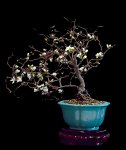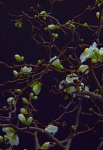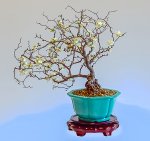You are using an out of date browser. It may not display this or other websites correctly.
You should upgrade or use an alternative browser.
You should upgrade or use an alternative browser.
Contorted White Flowering Quince
- Thread starter fredtruck
- Start date
garywood
Chumono
Thanks Brian! If by chance you can get one opened with stamen and pistil intact I would love to see it.Sorta...was out of town for the weekend and the blooms aren't quite as photographic as they were a few days ago.
View attachment 90950
Brian Van Fleet
Pretty Fly for a Bonsai Guy
Will do.
fredtruck
Omono
Yes, Camera+ is at the app store. And, thank you very much, Gary for the good words.
Vin
Imperial Masterpiece
I'm not really into stamens and pistils so I have to ask, why would you want a photo of them? Curiosity has got the best of me on this one.Thanks Brian! If by chance you can get one opened with stamen and pistil intact I would love to see it.
Nybonsai12
Masterpiece
You have a very nice tree Fred. You certainly have your own touch on the flowering species to make them beautiful and I love seeing them when you share, so thank you.
I have a contorted white quince and a toyo that have been in the ground growing for the last 3 years or so. I was debating digging them in the spring to either see if I think I can make something of them or to sell them off. I must admit I'm perplexed by how to style these as I really have only seen the clump style. I have to read the chapter in Peter Tea's book on them. I'm curious how you decide what direction to take them as from the little exposure I have to them, they don't lend themselves to a typical tree form. Also, how do they respond to heavy root pruning in your experiences?
I have a contorted white quince and a toyo that have been in the ground growing for the last 3 years or so. I was debating digging them in the spring to either see if I think I can make something of them or to sell them off. I must admit I'm perplexed by how to style these as I really have only seen the clump style. I have to read the chapter in Peter Tea's book on them. I'm curious how you decide what direction to take them as from the little exposure I have to them, they don't lend themselves to a typical tree form. Also, how do they respond to heavy root pruning in your experiences?
garywood
Chumono
Vin, I thought everyone was into a little quince sexI'm not really into stamens and pistils so I have to ask, why would you want a photo of them? Curiosity has got the best of me on this one.
fredtruck
Omono
fredtruck
Omono
You have a very nice tree Fred. You certainly have your own touch on the flowering species to make them beautiful and I love seeing them when you share, so thank you.
I have a contorted white quince and a toyo that have been in the ground growing for the last 3 years or so. I was debating digging them in the spring to either see if I think I can make something of them or to sell them off. I must admit I'm perplexed by how to style these as I really have only seen the clump style. I have to read the chapter in Peter Tea's book on them. I'm curious how you decide what direction to take them as from the little exposure I have to them, they don't lend themselves to a typical tree form. Also, how do they respond to heavy root pruning in your experiences?
The tree posted here is, depending on who's looking, either a single trunk or double trunk contorted white quince. With this particular tree, I let it grow for most of a season, and then made the decision to wire it so it would fold in on itself. Usually, I cut it back in early summer, and then let it grow until the fall, then cut it back again. I cut it to 1, 2 or 3 nodes, depending on design considerations. With this contorted quince, if I did that, I'd be cutting off everything that makes this little tree what it is, so I came up with the folding-it-back-on-itself idea. Now that I have a nice briar patch going, I will introduce another rhythm into the tree's growth, a little change of pace, but nothing drastic. So, in answer to your question directly, I let the tree tell me, on one hand, or I start with a bunch of cuttings to make a clump.
There are quite a few variations on the clump format. It's worth your while to look at some Kokofu books and other publications, like International Bonsai, which always (almost) has interesting quince pictures to look at.
Quince, according to the book, respond well to heavy root pruning, but I don't do it. The reason is that quince are susceptible to fungal issues. These can be devastating for the tree, so I like to have my quince as unstressed as possible. When I repot the quince, I take it out, check it over, and simply cut off roots that hang down. In the initial potting, I remove only what I have to. When I prune the branches, I seal the cuts. All of them. I use a couple different fungicides. With this regimen, my quince have really improved in health.
Thanks for your questions.
JudyB
Queen of the Nuts
I've been waiting for this one to show up, looking to be a good flowering session.
armetisius
Chumono
Cute plant and interesting flowering.
Kudos on the new plant.
Kudos on the new plant.
Cadillactaste
Neagari Gal
This one surprised me...didn't realize you had it. Love your explanation of future plans and current stages.
fredtruck
Omono
JudyB
Queen of the Nuts
The almost open buds are the ones I like the best. I had no idea the flowers were so persistent on these trees, being the first year for blooming on mine. But my pink one still has many blooms, and it's been going for a long time. Nice pics.
fredtruck
Omono
If you treat quince right, the flowering season is almost forever. Of course, that excludes the bonsai show season! Thanks for your comments and likes.
fredtruck
Omono
fredtruck
Omono
fredtruck
Omono
I have seen interesting color variations in the quince flowers, but nothing quite like this. A week or so ago, all the white flowers on the contorted white flowering quince turned pink, or pink and white. You can actually see some of this going on in the picture above. I did a little research and found that this color-change is due to the age of the blossom. Nothing really spectacular here, but interesting anyway.


Mellow Mullet
Masterpiece
I have seen interesting color variations in the quince flowers, but nothing quite like this. A week or so ago, all the white flowers on the contorted white flowering quince turned pink, or pink and white. You can actually see some of this going on in the picture above. I did a little research and found that this color-change is due to the age of the blossom. Nothing really spectacular here, but interesting anyway.
View attachment 102088
My white contorted did this, too this year.
JudyB
Queen of the Nuts
That is so cool that the blooms change to pink as they age. Wonder why this year but not past years? Some things are just mysteries...
Similar threads
- Replies
- 6
- Views
- 2K







